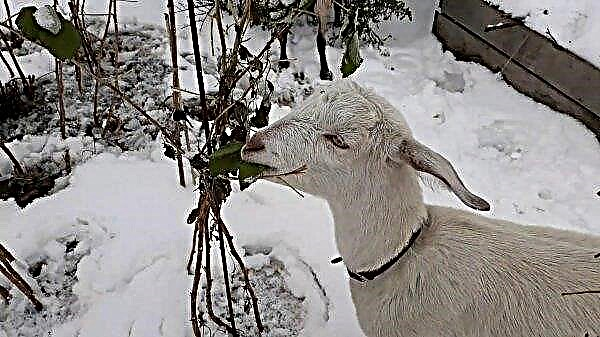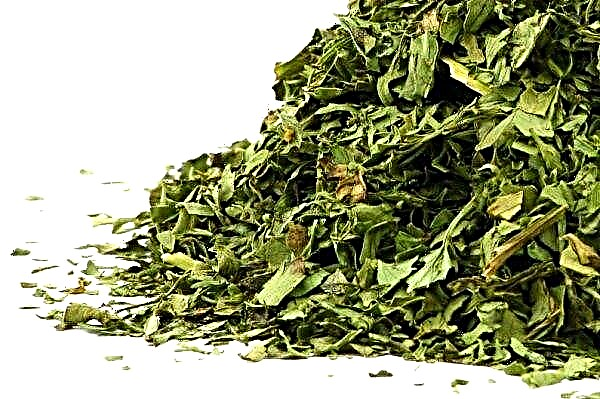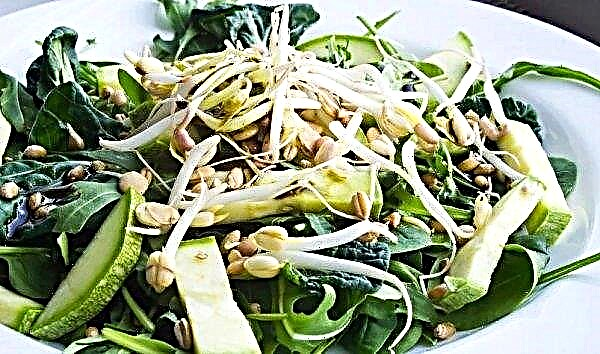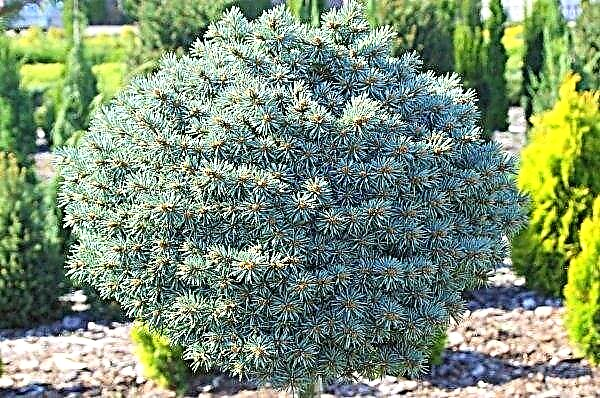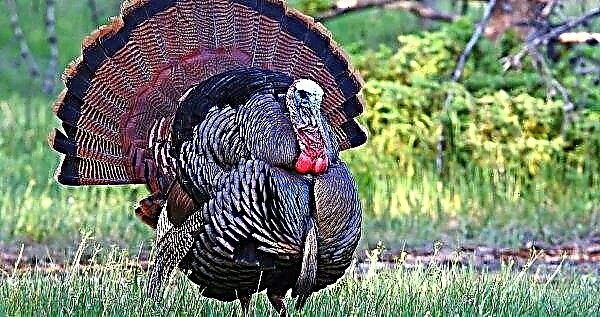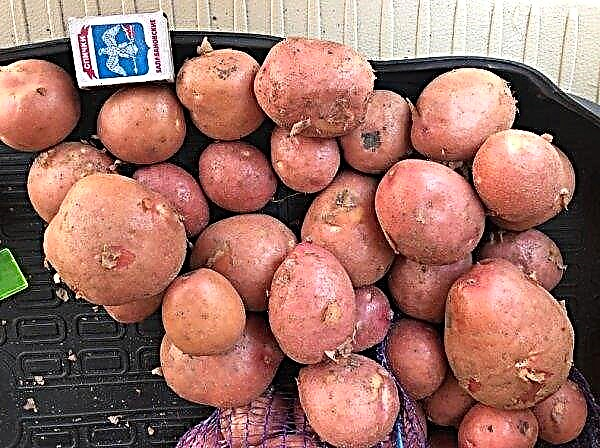An apple tree can rightly be called the most common tree in home gardens. Its juicy fruits are loved by both adults and children. However, few people know that among the apple trees there are also decorative species, such as the Berry apple tree. What are its features and why its fruits are practically not eaten - read on.
Description and characteristics of the species Apple tree Berry
Apple-tree Berry (Latin Malus baccata) is an unusual representative of the genus Apple-tree of the Pink family, notable for its extremely small fruits. Its homeland is called China, where it grows in the wild. It can also be found in the forests of Mongolia, Eastern Siberia, Korea, and even in northern European countries.

This species is actively used in decorating gardens, landscape areas, alleys, parks. Such a tree looks especially advantageous in autumn.when most other cultures lose their elegant look, and it is beautifully cast with sparkling fruits.
First of all, the appearance of such a tree attracts attention:
- he has a non-standard crown: spherical or umbrella-shaped;
- the leaves have a slightly elongated shape and are painted in shiny dark green color;
- the older the age of the apple tree, the more curved and winding its trunk, due to which an adult tree takes the form of a bush;
- the branches are long, thin, raised up;
- the bark is gray, but the intra-stem tissues have a beautiful brown-red color, the young rings of the tree are painted in a pleasant peach hue. These decorative properties are highly regarded in the furniture industry and art carvings.
Advantages and disadvantages
- Apple-tree Berry has several subspecies, for which typical advantages are characteristic:
- high frost resistance;
- undemanding to the soil;
- regular fruiting;
- strong immunity;
- compatibility with other apple species and varieties;
- excellent decorative qualities;
- the wood of such apples is great for crafts.
- As for the cons, the significant disadvantages are as follows:
- small fruition;
- unsuitability of fresh fruits for food;
- the crown thickens very quickly, and if you do not prune the branches in a timely manner, the tree will become vulnerable to the fungus.
The berry apple tree belongs to the trees of the third magnitude, since it is able to reach a height of 10 m. However, at home it is rarely grown above 5 m.
Annual growth
Representatives of this species grow extremely slowly. The growth of green mass and new shoots in the apple tree directly depends on the quality and regularity of top dressing and watering.
Important! If you follow all the necessary recommendations for care, then the annual increase will be 5 points, and not annual - 2.
The timing of flowering and fruit ripening
In May, small (up to 3 cm) light pink buds appear on apple branches. They are collected in inflorescences of 4-8 pcs., Which are odorless, but give a festive look to the tree. There are so many flowers on the crown that from a distance it resembles a foam cap. The flowering period lasts from 2 to 4 weeks.

Fruits appear only on trees older than 3 years. In September - October, the crown is decorated with small reddish apples, the size of which rarely exceeds 1 cm. Inside, the fruit is divided by leathery flaps into 5 chambers with seeds.
Such apples are tasteless fresh, so they are practically not consumed, but they look very beautiful as a decoration of the garden. And due to the small size, these fruits remain on the branches until December.
Did you know? The apples of this plant are very fond of birds, so often in the winter, birds feed exclusively on them.
Productivity
Small-fruited Berry apple-tree bears fruit regularly, if weather permits. It is characterized by high productivity, and most owners of such a tree use its fruits only as ornaments in the garden.
However, some housewives adapted to cook wonderful apples from small apples. After heat treatment, the fruits retain their shape and acquire a beautiful honey color.
Winter hardiness and disease resistance
The considered species is characterized by high frost resistance, therefore, does not require special preparation before the cold. Some of its varieties, bred for the northern regions, are able to tolerate temperatures up to -56 ° C.
Did you know? Apple-tree Yagodnaya is considered the most winter-hardy species in the world from the genus Apple-tree.
This plant is also highly immune.. If timely top dressing of the soil is carried out, regular watering and high-quality formation of the crown are ensured, the tree will independently resist any diseases.
Landing and care
In order to grow a healthy tree that will decorate the landscape, it is important to follow the rules of planting and caring for it.
Choosing a place and soil
Although the plant is not demanding on the soil, to achieve a better decorative effect it should be planted in alkaline or neutral soil. If the planting is to be planted in acidic soil, then it is preferable to produce it with ash. If the distance to the surface is less than 1.5 m, the root system of the tree will quickly decay. Often this variety of apple trees successfully grows on low-fertile lands where other crops do not take root. Like most apple trees, Yagodnaya loves well-lit areas, but it negatively refers to drafts and harsh winds.
If the distance to the surface is less than 1.5 m, the root system of the tree will quickly decay. Often this variety of apple trees successfully grows on low-fertile lands where other crops do not take root. Like most apple trees, Yagodnaya loves well-lit areas, but it negatively refers to drafts and harsh winds.
Landing technique
Saplings of this species are planted in spring or autumn.. In the first case, this is done in late March - mid-April (before the active movement of juices). In the fall, September is considered the optimal time so that the seedling has time to take root before the onset of cold weather.
They begin to prepare for planting the apple tree in 1-2 weeks, just then they dig a hole and allow it to be saturated with oxygen during this time. The size of the recess should be proportional to the crown of the young tree (tentatively, it is 50-60 cm in diameter and 60-70 cm in depth).
Video: Apple tree planting instructions
When planning to plant several apple trees, they take into account a comfortable distance for the development of apple trees - 5 m between them. With a decrease in this norm, situations are possible when the trees will obscure each other or infections between them will spread more actively.
The landing process itself is as follows:
- The seedling is lowered into the pit so that the root neck is 3-5 cm above the ground.
- Next, the roots are carefully straightened.
- Then they are sprinkled with a mixture of humus, fertile soil and sand (3 × 1 × 2). If desired, mineral fertilizers can be added to this substrate.
- After that, the earth around the seedling is tamped and moistened with high quality (15–20 buckets), and so that the moisture is stored longer in the soil, mulching is carried out.
Important! In the first three years, a young tree needs to be tied to a support, otherwise there is a risk that the wind will break it.
Watering
Apple tree Berry watered 2 times a month with a large volume of water. Fruiting apple trees require 7-8 buckets per 1 m² of tree trunk. After each watering, it is imperative to loosen the earth around the tree to improve aeration of the roots.
Fertilizers
One-year-old seedlings do not need fertilizers, but older specimens need regular top dressing. Their composition should include in equal proportions:
- nitrogen;
- phosphorus;
- potassium.
Pruning
Since the apple berry is classified as an ornamental plant, it needs annual corrective pruning. First, dry, broken branches are removed, and then the rest are cut to give the crown an appropriate shape. It is better to carry it out in March, until the tree begins to grow.
It is better to carry it out in March, until the tree begins to grow.
Winter preparations
Given the frost resistance of this species, the apple tree does not need special care. However, if you wish, you can play it safe and tie a shtamb, as well as fit the main branches with burlap. It is also useful to lime the trunk.
Pests and diseases
Despite the strong immunity, in the absence of proper care, the Berry apple tree may suffer due to pests or diseases, among which:
- powdery mildew;

- scab;

- bacterial burn.

Having found signs of the disease, it is necessary to immediately proceed to the treatment of the affected instance:
- powdery mildew will help chemicals ("Topaz") or treatment with soda solution (100 g of soap, 2 tbsp. l. soda per 10 l of water, process in 3 sets with an interval of 7 days);
- fungicides are used to treat scabs (Impact, Horus, Delan, etc.). If desired, you can try alternative methods: 10% solution of nitrate, bordeaux mixture (300 g of copper sulfate, 400 g of lime per 10 l of water);
- in the fight against a bacterial burn, the tree is treated with fungicides (“Skor”, “Acrobat”), sometimes with the use of antibiotics (“Fitolavin”, “Gentamicin”, etc.).
Important! If the disease could not be avoided, it is worth immediately removing the affected branches, leaves, fruits from the apple tree and be sure to burn them to prevent infection of other trees.
Harvesting, transportability and storage
Due to the astringency and acid of the apples of the plant in question, they are not eaten fresh, therefore they are rarely harvested. Mostly bright small fruits are used to decorate landscape areas. However, they are still edible. The fruits remain on the tree for a long time, so that harvesting can be carried out much later than ripening. The Yaglodnaya apple tree will be a wonderful addition to any green zone, delighting with a delicate color in spring, and with a golden crown and sparkling red small fruits in autumn. Keep apples in a dry and cool place. Their transportability is high, and even beginners can easily grow it, given the unpretentiousness and strong immunity of this northern tree.
The fruits remain on the tree for a long time, so that harvesting can be carried out much later than ripening. The Yaglodnaya apple tree will be a wonderful addition to any green zone, delighting with a delicate color in spring, and with a golden crown and sparkling red small fruits in autumn. Keep apples in a dry and cool place. Their transportability is high, and even beginners can easily grow it, given the unpretentiousness and strong immunity of this northern tree.




